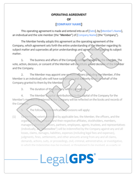How to Protect Your LLC Assets from Personal Estate Issues
Many LLC owners believe that their business is automatically protected from personal estate complications. However, events like probate, divorce, and...
9 min read
LegalGPS : Sep. 13, 2025
Running an LLC without proper asset protection is like driving without insurance—everything seems fine until disaster strikes. With lawsuits reaching record highs and business liability exposure growing more complex each year, 2025 has brought new challenges that make traditional protection strategies insufficient.
The good news? The right combination of agreements can create multiple layers of protection that shield both your business assets and personal wealth from potential creditors, lawsuits, and unexpected financial disasters.
Economic uncertainty has created a perfect storm for business litigation. Small businesses face an average of 1.2 lawsuits per year, with legal costs averaging $54,000 even for cases that never reach trial. Meanwhile, personal liability claims against business owners have increased by 23% since 2023.


Legal GPS Pro
Protect your business with our complete legal subscription service, designed by top startup attorneys.
Your LLC's limited liability protection only goes so far. Without proper agreements in place, creditors can pierce the corporate veil, personal guarantees can expose your assets, and business disputes can drain resources that should fuel growth. The entrepreneurs who thrive in today's environment understand that asset protection isn't paranoia—it's smart business planning.
Modern asset protection requires more than basic LLC formation documents. It demands a comprehensive strategy built on carefully crafted agreements that anticipate threats before they materialize.
Most LLCs operate with generic, one-size-fits-all operating agreements that provide minimal protection. These basic documents leave massive gaps that savvy creditors and litigators know exactly how to exploit.
A properly structured operating agreement serves as your primary shield against both internal disputes and external threats. It establishes clear boundaries around member liability, defines asset ownership, and creates procedural barriers that make it difficult for creditors to access LLC assets.
Your operating agreement should include specific charging order protections that limit creditors to only the economic rights of membership interests, not voting or management rights. This makes LLC interests far less attractive to creditors since they can't actually control the business or force distributions.
The agreement must also establish clear asset segregation protocols. When business assets are properly ring-fenced through operating agreement provisions, it becomes much harder for creditors to claim that assets are actually personal property of the members.
Marcus owned three successful restaurants through separate LLCs, each with standard operating agreements downloaded from a legal website. When a customer sued one restaurant for food poisoning, the attorney discovered that the generic agreements had no charging order protections and weak asset segregation language.
The creditor's attorney successfully argued that equipment and inventory were actually Marcus's personal assets being used by the business, rather than true LLC property. This "alter ego" argument allowed them to pursue Marcus's personal assets, including his home and investment accounts. Marcus ended up settling for $340,000, despite the original claim being only $75,000, because fighting the personal liability exposure would have cost even more.
A properly drafted operating agreement with strong charging order provisions and clear asset ownership language could have limited the creditor to pursuing only the LLC's assets, protecting Marcus's personal wealth entirely.
Beyond your operating agreement, several specialized agreements create additional layers of protection. Each serves a specific purpose in your overall asset protection strategy, and the combination provides far more security than any single document.
Management agreements transfer operational control to separate entities, creating distance between you personally and day-to-day business decisions that could generate liability. Equipment leases move valuable assets outside the LLC while still allowing business use. Professional services agreements establish clear boundaries around liability for advice and recommendations.
A management service agreement transfers the operation of your LLC to a separate management company, which you can also control. This creates legal distance between you and the operating business, making it harder for creditors to pursue personal liability claims.
The management company (often another LLC) contracts with your primary LLC to handle daily operations, hiring decisions, and strategic planning. If the operating business faces liability, creditors find it much more difficult to pierce through multiple entity layers to reach your personal assets.
Create two LLCs: one that owns valuable assets (real estate, equipment, intellectual property) and another that operates the business. The operating entity leases everything from the asset-holding entity. If the operating business gets sued, there are fewer assets for creditors to claim since the valuable property belongs to the separate asset-holding LLC.
Moving valuable equipment, vehicles, and property outside your operating LLC protects these assets from business creditors. You can lease these assets back to your LLC through formal lease agreements, maintaining business use while creating legal separation.
The lease payments also provide legitimate tax deductions for the operating business while generating rental income that can be structured advantageously for tax purposes. Most importantly, creditors of the operating LLC cannot seize assets that legally belong to other entities.
Jennifer runs a construction company that owns $500,000 worth of specialized equipment. Instead of keeping everything in one LLC, she created three entities: an operating LLC that runs the construction business, an equipment LLC that owns all tools and machinery, and a property LLC that owns the commercial building.
When a subcontractor sued the operating LLC for alleged construction defects, creditors could only pursue the assets of that specific entity. The equipment and real estate remained completely protected because they belonged to separate LLCs. The operating company's main assets were accounts receivable and some inventory—the lawsuit settled quickly for $45,000 rather than the $200,000+ originally demanded because there simply weren't enough accessible assets to justify an expensive legal battle.
This structure cost Jennifer about $3,500 to establish but saved her hundreds of thousands when litigation hit.
Some businesses face inherently higher liability risks that require more sophisticated protection strategies. Professional services, manufacturing, healthcare, and construction companies need multi-layered approaches that anticipate industry-specific threats.
Advanced strategies might include domestic asset protection trusts, series LLCs in appropriate jurisdictions, and international structures for businesses with global operations. The key is matching the complexity of your protection strategy to your actual risk profile.

LLC Asset Protection Agreement
Shield your most valuable assets from creditors and legal threats. This agreement sets up internal protections to help preserve business continuity and minimize risk exposure.
Trusted by 1,000+ businesses to safeguard their LLCs.
In states that allow them, series LLCs create separate liability compartments within a single entity. Each series can own different assets, conduct different business activities, and maintain separate liability shields from other series.
This structure works particularly well for real estate investors, franchise operations, or any business with multiple distinct revenue streams or asset categories. If one series faces liability, the assets and operations of other series remain protected.

For business owners with significant personal wealth, domestic asset protection trusts (DAPTs) provide an additional layer of protection beyond LLC structures. These trusts, available in about 17 states, allow you to be a beneficiary of a trust that holds your assets while protecting those assets from future creditors.
Not all states provide equal asset protection benefits. Nevada, Delaware, and Wyoming offer particularly strong LLC protection statutes, including single-member LLC charging order protection and strong privacy provisions. Consider forming your LLCs in these states even if you operate elsewhere, provided you comply with foreign qualification requirements in your home state.
When properly structured, DAPTs can hold LLC interests, real estate, investment accounts, and other valuable assets while maintaining some level of access for the trust creator. This creates powerful protection against both business and personal liability claims.
Dr. Sarah Chen operates a dermatology practice through a Nevada LLC while living in California. Her practice generates $1.2 million annually, creating significant malpractice exposure despite insurance coverage. She implemented a multi-layered protection strategy that includes:
Her medical practice LLC leases equipment from a separate equipment LLC, and leases the building from a Nevada property LLC. Her personal assets, including investment accounts and her home, are held in a Nevada DAPT that she established as both settlor and beneficiary.
When a patient filed a $2.3 million malpractice claim alleging misdiagnosis, the comprehensive structure proved its worth. The malpractice insurance covered $1 million, but the additional exposure couldn't reach her personal assets due to the trust protection, or the equipment and real estate due to the separate entity ownership.
The case settled within the insurance limits because pursuing additional assets would have required expensive litigation against multiple entities across different jurisdictions—something the plaintiff's attorney wasn't willing to undertake on a contingency basis.
Even well-intentioned business owners often make critical mistakes that undermine their protection strategies. These errors can completely eliminate the liability shields they thought they had created, leaving personal assets exposed to business creditors.
The most dangerous mistakes involve failing to maintain proper formalities, commingling personal and business assets, and creating structures that appear designed solely to avoid creditors rather than serve legitimate business purposes.
Courts will pierce LLC protection when the entity appears to be merely an "alter ego" of its owner rather than a legitimate separate business. This happens when LLCs are inadequately capitalized, fail to maintain separate bank accounts, or don't follow basic corporate formalities.
Your LLC must have enough initial capital to reasonably conduct its intended business. While there's no specific dollar amount required, courts look at whether the capitalization was reasonable given the business's anticipated liabilities and operations.
Maintaining formalities means keeping separate books and records, holding required meetings, and documenting major decisions in writing. Even single-member LLCs must maintain these practices to preserve liability protection.
Robert operated a successful IT consulting practice through an LLC he formed five years ago. He contributed $500 to the LLC initially and never added more capital, despite the business generating over $300,000 annually. He used the business bank account for personal expenses, never held member meetings, and kept no written records of business decisions.
When a client sued for alleged data security failures, the opposing attorney easily demonstrated that Robert's LLC was merely his alter ego. The court pierced the corporate veil, holding Robert personally liable for the full $180,000 judgment plus attorney fees.
Proper capitalization, separate accounting, and basic formality maintenance would have preserved the LLC's liability shield. Robert's attempt to save money on administrative requirements cost him nearly $200,000 in personal liability.
Creating asset protection structures after legal troubles begin can backfire spectacularly. Courts will unwind transactions that appear designed to hinder, delay, or defraud creditors, potentially exposing you to additional penalties.
Effective asset protection must be implemented before you need it. Generally, structures created more than four years before any creditor claims are presumed legitimate, while those created within two years of liability issues face much greater scrutiny.
Schedule an annual review of your asset protection strategy with qualified professionals. Business changes, new assets, evolving liability exposure, and changing laws all affect the adequacy of existing protection. What worked perfectly three years ago might have dangerous gaps today.
While basic LLC asset protection strategies can be implemented using quality templates and self-help resources, complex situations require professional guidance. Attempting advanced strategies without proper legal and tax advice often creates more problems than solutions.
You need professional help when your business involves high liability risks, when you're implementing multi-entity structures, or when your personal net worth exceeds $1 million. International operations, professional licensing requirements, and existing legal disputes also require expert guidance.
The cost of proper professional planning is almost always less than the cost of inadequate protection when liability strikes. A $5,000 investment in comprehensive planning can prevent hundreds of thousands in losses during litigation.
Certain warning signs indicate your current protection strategy needs immediate professional evaluation. These include operating in multiple states, having personal guarantees on business debts, facing potential professional liability claims, or owning real estate through your operating LLC.
Changes in your business model, new partnership arrangements, or significant increases in revenue also trigger the need for protection strategy updates. What protected a $100,000 business adequately may be completely insufficient for a $1 million operation.
Maria started an online jewelry business five years ago using a simple LLC and basic operating agreement. The business grew from $50,000 in first-year sales to over $2 million annually by 2024. Her success attracted competitors who began filing trademark infringement claims and product liability suits.
Maria's original single-LLC structure left all business assets exposed to these claims. She implemented a comprehensive restructure that included separate LLCs for inventory, intellectual property, and operations, plus a management company and domestic asset protection trust.
The restructure cost $12,000 in legal and accounting fees, but when a major trademark lawsuit was filed six months later, the comprehensive structure limited the claimant's access to assets and forced a reasonable settlement of $25,000 rather than the $400,000 originally demanded.
Legal GPS provides professionally-drafted asset protection templates and comprehensive guidance for implementing multi-layered LLC protection strategies. Our Pro subscription includes access to advanced operating agreements, management service agreements, equipment lease templates, and step-by-step implementation guides.
For businesses with complex protection needs, Legal GPS connects you with experienced asset protection attorneys who understand both the legal requirements and practical implementation challenges. This combination of self-help resources and professional guidance provides cost-effective protection for businesses at every stage.
Effective asset protection requires immediate action and ongoing maintenance. Start by evaluating your current LLC structure against the protection standards outlined above, then prioritize the gaps that create the greatest vulnerability.
Begin with your operating agreement review—this single document can provide substantial protection improvements even before implementing more complex strategies. Focus on charging order protections, asset segregation provisions, and formality requirements that preserve liability shields.
Move next to asset segregation strategies that remove valuable property from your operating entity's reach. Equipment leases, real estate separation, and intellectual property licensing create immediate protection improvements with relatively simple implementation.
The entrepreneurs who thrive despite increasing litigation risks are those who view asset protection as an essential business system, not an optional luxury. Your protection strategy should evolve as your business grows, always staying ahead of potential threats rather than reacting to them.
Start your comprehensive asset protection review today. Your future self—and your family's financial security—depend on the decisions you make now, before you need the protection these strategies provide.

Legal GPS Pro
Protect your business with our complete legal subscription service, designed by top startup attorneys.
|
Premium Template
Single-use Template |
Legal GPS Pro
Unlimited Access, Best Value |
|
|
| Choose Template | Learn More |
| Trusted by 1000+ businesses | |
Table of Contents

Many LLC owners believe that their business is automatically protected from personal estate complications. However, events like probate, divorce, and...

Most entrepreneurs understand the importance of having a will, but many overlook a critical component that could make or break their business legacy....

Divorce can have serious financial and legal consequences for LLC owners, affecting everything from business ownership to estate planning and tax...